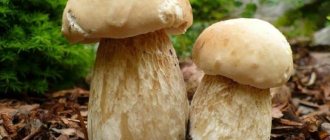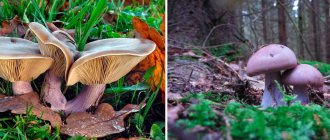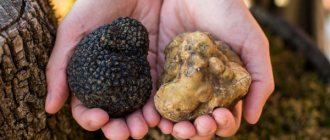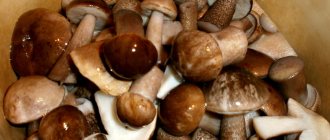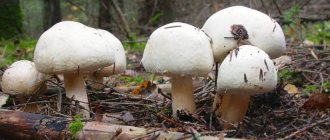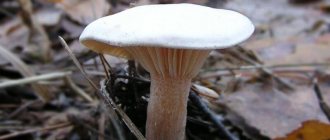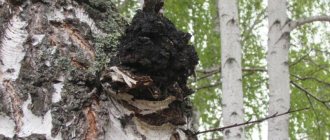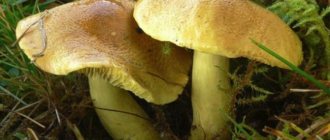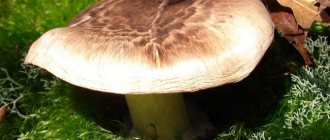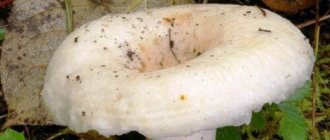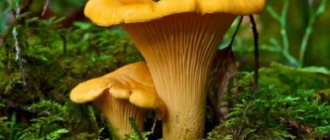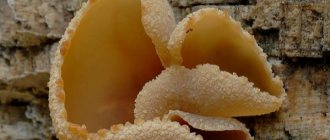The blue leg or blue leg mushroom has the scientific name two-colored row or lilac-legged row. In Latin it sounds like Lepista personata. This species belongs to the conditionally edible mushrooms, and is part of the family of ordinary mushrooms. The blue leg is very easy to distinguish by its special coloring. This is the main distinguishing feature. There are also other main signs by which you can recognize this mushroom and not be mistaken for its poisonous or inedible counterparts. This article will provide all the characteristics of the blue leg, how and when it is collected, whether it is possible to grow them in artificial conditions and whether it is worth doing it at all.
Botanical description of the mushroom
Bluefoot (two-colored mushroom (lilac-legged), boletus, blue root, Lepista personata) is a conditionally edible mushroom from the rower family. It is easy to recognize by its characteristic color and other distinctive features: A flat-convex cap of a light yellow, slightly purple hue. Its average diameter reaches 10 cm, but there are also giant mushrooms with a cap up to 25 cm in diameter.
Its surface is smooth; At the bottom of the cap there are plates, yellowish-cream in color; The leg is slightly thickened at the base, with a smooth surface. Its length is usually no more than 10 cm, thickness is about 3 cm. In young specimens, remnants of the “spread” in the form of flakes are visible on the stem and a fibrous structure is noticeable.
The color is bright, lilac or gray-violet, sometimes with a bluish tint. The main characteristic of the bluefoot is its bright colors. This scares away mushroom pickers. But the nutritional properties are good. It has a pleasant taste, somewhat similar to champignon. There are other names for this mushroom:
- lilac-legged row;
- two-color row;
- bluefoot;
- captain;
- blue root;
- Lepista personata;
- Lepista saeva.
Description of individual parts of the mushroom
- Cap of the lilac-legged rower has a cushion-shaped, flat-convex cap, which flattens slightly with age. The cap is fleshy, with edges curved inward, which in older specimens may turn slightly outward. Its surface is smooth and slightly oily to the touch, its color is yellow-brownish with a slight purple tint. The diameter of the cap can reach up to 15–16 cm. It will be useful for you to read about which mushrooms are edible and poisonous, which edible mushrooms grow in autumn and May, and also learn how to test mushrooms for edibility using folk methods.
- Plates The two-color row belongs to the lamellar mushrooms: its plates are wide, frequent, free or attached in a notched manner. The color of the plates is yellowish, cream, gray or pinkish cream. Young specimens have whitish plates.
- Pulp Blueleg pulp has a dense and thick structure, which becomes looser with age. Its color is light lilac, gray-violet, gray and grayish-brown are also found. The pulp has a pleasant mealy aroma, and its sweetish taste resembles champignon. If you decide to cook older specimens of bluelegs, then before doing this you should remove the lower spore-bearing layer of the cap - the plates, since the numerous mature spores contained in them are practically not digested.
- Leg The main distinguishing feature of a two-color row is its leg. It has a clear purple tint, and the younger the specimen, the more expressive the color. Also, the legs are grayish-purple, and sometimes even bluish. There are mushrooms with a light stalk and distinct bluish and purple fibers located on it. The stem of young mushrooms is covered with flakes with a clear fibrous structure, which represent the remains of the blanket. With age, its surface becomes smooth. The shape of the leg is smooth, dense, slightly thickened at the base. Its height reaches 10 cm and diameter 3 cm.
Rules for collecting blue-legged mushrooms
The distribution area of this fungus is the temperate zone of the Northern Hemisphere. It is found both in America and Europe in meadows, gardens, plantings and forests. The places where the blue leg mushroom grows have soil rich in humus. These could be: peat bogs; compost pits in the garden; meadows with chernozem soils; forest hollows with rotten leaves accumulated in them, etc. Connoisseurs and connoisseurs of “quiet hunting” do not wonder when to collect the bluepod mushroom - it bears fruit from April to the end of October. Easily tolerates light frosts down to -5 degrees Celsius. Like all row trees, the blue leg grows in families. Sometimes you can collect up to 20 kg of this tasty mushroom in one place. Groups forming a ring look exotic; they are also popularly called “witch circles.”
The purple-legged rower is common in the temperate climate zone. The mushroom is widespread in Russia. In addition, the blue leg is found in the forests of South and North America. The lilac-legged row usually grows under ash or coniferous trees. Large accumulations of these fungi are observed in places where there is humus, in meadows in areas of livestock grazing, and in areas of fallen leaves.
When collecting mushrooms, you need to take into account the following recommendations: it is better to collect bluelegs in sunny weather, since in humid conditions their caps become covered with mucus and become unpleasant to the touch, the slippery surface of the mushroom will create difficulties when cutting; to find large colonies of mushrooms, you need to go to open, bright meadows; You should not try bluelegs raw; they are classified as conditionally edible mushrooms and require heat treatment.
This mushroom is common in the temperate zone of the Northern Hemisphere. It is collected in the European part of Russia, Kazakhstan and the Black Sea region. True, in the south it produces two harvests per year: it appears in the spring and then in the fall.
In the Rostov region, there are 6 places where bluelegs grows. Among them:
- Territory of Chertkovskaya district;
- Tarasovsky district and surrounding areas;
- Forest strip running next to the Don River;
- Planting pine trees in Millerovsky district;
- Semikarakorsky district;
- Shchepkinsky forest.
Be careful when going into the forest in spring and summer. During the period of awakening, vipers are very dangerous. The poison accumulated over the winter can be fatal.
But to the north, bluelegs are found only in August. This mushroom can withstand light frosts, so it is collected until October - November. Of the trees, the rower prefers ash or coniferous species, but chooses forest belts or open forests.
Very rarely it grows alone, most often it forms “witch rings”. And every year, under favorable conditions, the blue leg grows in the same place. Therefore, mushroom pickers know these places and in a good season they collect up to 200 kilograms. Young bluelegs are very attractive, resembling round buns on top.
After all, their cap is fleshy, dense and semicircular. It is convex, and the edge turns slightly inward. Its color is most often matte cream or yellowish with purple streaks. And young mushrooms have a bright purple cap. Its surface is always smooth and shiny, but in the absence of rain it becomes dry and fades. The size of the cap can reach 25 centimeters. violet hue, and with age they become yellowish or purple. And the spore powder is pale pink. The pulp is dense and fleshy, turns purple when broken and emits a pleasant fruity smell.
Old mushrooms or those that have survived frosts lose their purple tint and become yellowish. It is better not to take such saprophytes, because, in addition to the fact that they are easily confused with inedible ones, they become tasteless. The fruiting bodies of the lilac-legged row most often grow in steppe zones, as well as in small deciduous forests. Ryadovka is a saprophyte that grows quickly in the presence of rotting leaf litter. Fruiting bodies often grow not only on soils, but also on the litter, near brushwood and straw. The purple-legged rower is also found on fallen needles in coniferous and mixed forest zones. The mushroom is quite large in size with a fleshy, hemispherical, convex-spread or convex cap, which has thin edges turned down.
Covered with smooth and shiny skin of bright purple or brownish-ocher color. The fleshy mushroom pulp is characterized by sufficient density, light purple or ocher-cream color, with a weak but pleasant taste and a slight anise smell. Thin plates are quite often located, almost free type, pale violet in color, with a brownish tint. The leg is dense, cylindrical in shape, with a slight thickening at the base, sometimes club-shaped, with a smooth surface, of a distinct longitudinal fibrous type. The base of the leg is distinguished by noticeable purple pubescence.
The spores are ellipsoidal in shape, slightly rough, pinkish, pale pink or pinkish-yellow in color. Saprophytes grow en masse individually or in groups on rotting leaves, on soils and needles, as well as near straw. The variety prefers conifers and mixed forest zones, as well as compost heaps. Fruiting bodies tolerate minor frosts quite easily, so they are formed during the period from the last summer month to the last ten days of autumn. The species has become widespread in the temperate climate zone. Such mushrooms grow en masse throughout the Northern Hemisphere and in Australia.
Where do blue legs grow?
This mushroom is common in the temperate zone of the Northern Hemisphere. It is collected in the European part of Russia, Kazakhstan and the Black Sea region. True, in the south it produces two harvests per year: it appears in the spring and then in the fall. But to the north, bluelegs are found only in August. This mushroom can withstand light frosts, so it is collected until October - November. Of the trees, the rower prefers ash or coniferous species, but chooses forest belts or open forests. Very rarely it grows alone, most often it forms “witch rings”. And every year, under favorable conditions, the blue leg grows in the same place. Therefore, mushroom pickers know these places and in a good season they collect up to 200 kilograms.
Blueleg is predominantly a southern mushroom. But in general it is found throughout Russia, including in the Moscow region. It can be found most often in meadows or pastures. They grow in colonies, so when you see them, you can’t go wrong. You will come across small “islands” in the form of a circle or “path”. And sometimes you can see them very close. Podavniki love soils rich in organic matter. Therefore, they often appear near farms, houses and even in compost ditches.
In the forest, on the contrary, you will rarely see this species; they prefer well-lit spaces. But, if there are several colonies in the thicket, then under deciduous trees. Very tasty and popular among mushroom pickers is the meadow lilac-legged row. Its name speaks for itself, because it grows in pastures and meadows. In its taste and properties, this fruiting body is similar to champignons. In the marinade, the row takes on a snow-white appearance and amazing taste. However, experts believe that meadow row and lilac-legged are the same type of mushroom.
Where does the lilac-legged row grow and what places does it prefer to grow? Here everything will depend on soil and climatic conditions. Rows grow in all kinds of soils, and if the weather is favorable, then the harvest of these fruiting bodies will be large. In addition, the lilac-legged rower can be found in urban forest parks and in private plots.
The two-color row is widespread in the temperate zone of the Northern Hemisphere, in Kazakhstan, the Black Sea region and in the European part of the Russian Federation. But we must not forget that even edible types of grass, which are collected within the city or near industrial enterprises, are much more toxic than their meadow and forest counterparts. Very often, such mushrooms cause poisoning.
When to collect purple-footed row, so that it is not overgrown and retains all its beneficial vitamins and properties? I would like to say that these fruiting bodies, especially those growing in the southern regions of the country, can produce 2 harvests per year. The first appears in the spring and lasts until the beginning of autumn, and the second begins at the end of summer and continues until the first frost, that is, almost until the month of November.
Under favorable weather conditions and with proper cutting of the row, mushroom pickers can collect these fruiting bodies in the same place for several years. Experienced mushroom pickers, knowing the places and timing of fruiting of the bicolor row, can collect from 100 to 150 kg of these mushrooms per season. Mushroom pickers love to collect it due to its dense pulp and resistance to transportation. Even after collecting the row in bags, you don’t have to worry: until you bring it home, it won’t break.
When does the bluefoot appear?
The fruiting bodies are resistant to cold, so they can be found even in late autumn and even in December. But other types of mushrooms do not have this ability, except for winter mushrooms. The lilac-legged row grows on moist, humus-enriched alkaline soils and belongs to the category of southern mushrooms. Widespread in Europe and America, it loves open areas - forest glades, river banks, meadows, pastures and farms.
Sometimes found in forests, especially near deciduous trees. Bluefoot grows in colonies, forming quite large circles or rows. This allows you to pick a whole basket of mushrooms, practically without leaving one place. The bluefoot is distributed throughout Russia; it can be found both in the Moscow region and in the Ryazan region. The fruiting season begins in April and lasts until the end of October, but the most active time is autumn. The lilac-legged row is common in the territories of Russia, which belong to Eastern Europe, as well as in the southern regions.
The blue leg fell in love with coniferous forests and pine forests. They grow side by side, on islands, so you can quickly collect a whole basket without moving from place to place. Purple-footed creatures hide under fences and under fallen leaves. It is known that each type of mushroom prefers to grow under a particular tree. Rowing is an exception to the rule, and chooses soil that is well fertilized with manure. The first bruises appear in mid-spring. August and September are the best times for picking mushrooms. It should be remembered that after rain, the pads become unpleasant to the touch and slip in your hands.
Therefore, there is no need to collect them in wet weather. Below is a list of useful recommendations:
- Mushrooms grow only in sunlit areas. You should not look for them in the dark density of the forest;
- In order not to spend a lot of time at home on processing, after picking a blue leg, you should immediately cut off the stem of the mushroom from the bottom;
- The spores, which are located on the lamellar section of the row, complicate digestion. Once in the stomach, they can cause poisoning. Therefore, the lower part of old mushrooms must be cut off;
- Mushroom pickers advise collecting mushrooms before 12 noon.
You should not collect very old or wormy mushrooms - they can cause poisoning. There are mushrooms that look like bluepods. It is important to know what they look like so as not to confuse edible boletus with poisonous ones:
- Purple row. It has a cap of the same color, which is very reminiscent of a real blueleg. But in the latter it is a little purple, while in the former the color is more saturated and bright;
- Gossamer violet. It resembles a blueleg, but has a characteristic “veil” at the bottom of the cap;
- The row is weedy. Similar to the podtavnik, but much smaller.
The listed mushrooms are considered conditionally edible. But there is another representative that looks like a blue leg. It is called the white-violet spider web and is poisonous. When broken, you can see that its flesh has a yellow tint. Often there are purple spots on it.
Useful properties and restrictions on use
The row is rich in B vitamins, as well as manganese, copper and zinc. This species is actively used not only in cooking, but also in medicine, because cyanosis is used for the production of antibiotics and antifungal agents.
In addition, cyanosis reduces glucose levels and has an anti-inflammatory and immunostimulating effect. Cobweb has similar beneficial properties as cyanosis, since it contains identical beneficial substances and trace elements.
Gossamer violet
Petsitsa, in turn, has a positive effect on clarity of vision, thins the blood and thereby prevents the appearance of varicose veins and thrombophlebitis. Pepper tincture is used to treat kinetosis. Petsica also contains a large amount of vitamin C, which improves human immunity.
Good to know!
Lakovice has a good effect on the functioning of the cardiovascular system, lowers blood pressure, cleanses blood vessels and increases the level of hemoglobin in the blood. In addition, varnish helps strengthen enamel and improves the general condition of the body.
Mushrooms should not be abused by people with gastrointestinal diseases. And in case of serious diseases, such as ulcers, gastritis, pancreatitis, you should completely stop using them. Also, this product should not be consumed by children under 10 years of age and pregnant women, since it is quite difficult to digest and absorb by the body.
You may be interested in:
What is the name of a mushroom with a red cap and its description (24 photos) Very often, mushroom pickers encounter many different mushrooms with a red cap in the forest. They usually look very...Read more...
Where and when to collect blue root mushroom
The blue leg row mushroom prefers to grow on alkaline soils, which are found in meadows, forest glades, in areas of abandoned farmland or in pastures throughout Russia. This amazingly beautiful mushroom grows in large colonies, in the form of rows or, as people often say, “witch circles.” Bluelegged row is widespread in Russia, as well as in European countries. In addition, it is found in the forests of North and South America.
The collection season and active fruiting of the blue-legged mushroom occurs at the beginning of autumn, that is, in the month of September. Experienced mushroom pickers recommend that novice lovers of “silent hunting” collect these fruiting bodies only in dry weather, since during rains they become slippery and sticky. Even despite the strange specific color that scares off many, the lilac-legged rower has its fans. Once having tasted it, mushroom pickers immediately join the lovers of these mushrooms. Having found rows in the forest, they will definitely collect them in their baskets. Then you can prepare a variety of tasty and aromatic dishes from them.
It is worth saying that the two-color rower belongs to the Ryadovkov family, which has a large number of species:
- the row is crowded, poisonous,
- brindle, white lepista,
- lepista serayai etc.
Beginning mushroom pickers are very interested in the question: where and when to collect blue root? First of all, pay attention to the photo and description of the purple-legged mushroom and compare it with the photo and description of the blue root mushroom. As you can see, this is the same representative. These mushrooms grow near rivers and lakes, near cattle farms right in the grass, in meadows and pastures.
The growth of these fruiting bodies begins from mid-April to early June, and then continues from the end of August until the first frost. Sometimes mushroom pickers harvest 2 crops in a few months. A photo of the blue root mushroom will help you determine what this fruiting body looks like, as well as the places this mushroom prefers:
It is worth saying that among the lily-footed rows there are also inedible species, although there are no deadly poisonous ones. The worst thing that can happen is a long-term disorder of the digestive system: diarrhea, weakness, abdominal pain and even loss of consciousness. Symptoms of poisoning can begin in just 30 minutes and no later than 2 hours after the mushrooms have been eaten. The illness can last from 3 days to 1 week and usually ends with recovery.
Growing at home and in the country
Since bluelegs grows on humus, it is recommended to prepare a nutrient substrate before planting. To do this, mix chopped straw (10 kg) and fresh bird droppings (7 kg). Stir, add water and leave for a month. Be sure to stir the mixture periodically.
To collect several harvests throughout the season, it is better to plant in the spring, after the frosts have gone. Step-by-step cultivation of bluelegs:
- Prepare the mycelium in light partial shade - dig shallow trenches (about 15 cm deep).
- Mix the mycelium and prepared substrate and fill the trenches.
- Moisten the mycelium, cover with film.
- After a few weeks, purple areas will be clearly visible on the surface of the substrate (this is the mycelium sprouting), cover it with an additional layer of soil (about 3-5 cm).
- Do not use the film anymore - in a few months the first mushrooms will appear.
The main rule for caring for bluefoot is to regularly moisten the substrate, preventing it from drying out. For the winter, it is advisable to cover the mycelium with old bags or agrofibre and a layer of leaves (spruce branches, straw). It is necessary to insulate after stable frosts - a thaw can lead to the development of mycelium.
Bluefoot is a wonderful trophy both for mushroom gourmets and for admirers of traditional medicine or home cosmetology. It is not difficult to benefit from this variety of mushrooms - just adhere to the technology of preparing dishes or homemade medicines, use only high-quality raw materials and do not engage in dangerous experiments.
False doubles of the blue stem mushroom
Although the purple-legged rower has very characteristic external features, it can still be confused with other mushrooms. Lookalikes exist both edible and inedible, so it is important to be able to distinguish them from each other in the conditions of the autumn forest.
Purple row
The two varieties belong to the same genus and are therefore very similar to each other in size, cap and stem structure. However, the purple-legged bluefoot has a purple tint only on the leg, while the violet row is distinguished by a uniform purple color. Like the purple-legged rower itself, its counterpart also belongs to the conditionally edible category.
Purple row
Weed row
The lilac-legged rower is very similar to another mushroom from the genus Lepista. But the weedy, or dirty, row has a couple of important differences - the entire fruiting body is colored purple, and besides, the dirty row is much smaller in size than the blueleg.
Weed row.
Lilac lacquer
The varnish slightly resembles the blueleg in shape and color, but it is quite difficult to confuse the mushrooms with each other. The lilac lacquer is much smaller in size, the diameter of its cap on average reaches only 5 cm. The shade of its cap is dark purple, but the leg is light, whitish. The lilac-legged rower differs from the lilac lacquer in that the latter can often be seen not in open space, but in dense forests. It can be eaten, but only after processing.
Lilac varnish.
Purple web spider
This edible mushroom has a bright purple stem and cap; when young, it is very similar in structure to the blueleg. You can distinguish the varieties from each other by color - in the spider plant it is uniform throughout the entire fruiting body, in addition, there are remains of a spathe on the stem, and adult rows have a smooth stem.
Purple web spider.
White and purple web spider
The inedible spider web and the harmless purple-legged rower are similar to each other in their flat-convex shape and the pale shade of the cap. But the leg of the cobweb is usually lighter than that of the row, and the flesh when cut is soft and loose. The main distinguishing feature of inedible spider webs is the presence of a distinct moldy odor.
White and purple web spider
Goat's web
This mushroom can be confused with blueleg due to its similar coloring. But the purple-legged rower has a leg darker in color than the cap, but the goat's webwort usually has a cap with a purple tint and a lighter leg. The mushroom is classified as inedible and smells unpleasant; according to mushroom pickers, its aroma is most reminiscent of acetylene.
Goat's web
Pure mycena
Inedible mycena with hallucinogenic properties has a flattened cap with a tubercle in the center, and its cap and stem are purple in color. But the stem of the mycena is lighter than the cap, and most importantly, the mycena is characterized by its miniature size. If it can rise 8 cm above the ground, then the diameter of the cap most often does not exceed 5 cm.
Tips for collecting purple-footed row or lepista saeva
Regarding the collection of the lilac-legged mushroom, experienced mushroom pickers give some useful advice to those who are going on a “quiet hunt” for the first time.
- It is better to look for fruiting bodies in illuminated forest clearings, meadows and pastures. In the shady wilderness, these mushrooms are less common.
- Cut off the lower part of the stem while still in the forest, so that you spend less time cleaning it at home.
- Never try raw mushrooms, because edible ones can easily be confused with poisonous types.
- Aging specimens of rows of bluepods must be properly cleaned before use: remove the lower spore-bearing layer of the cap, that is, the plates. The spores contained in the blades of ripe rows are not digested and can cause poisoning.
- Before heat treatment, the blue root mushroom must be soaked in cold water for 40 minutes to rid the fruiting bodies of adhering dry leaves and sand. Then rinse 2 times with plenty of water, pouring clean water each time.
- When soaking, you should add a little coarse table salt, which will rid the mushroom of worms.
- Do not use wormy or rotten specimens for food, as they can cause severe gastrointestinal disorders in a person with weakened digestion.
In order for the lilac-legged row to retain its color and aroma when boiled, cooks advise adding a pinch of citric acid to the boiling water.
Inedible species
These are harmless mushrooms, but they are impossible to eat due to their pungent taste and unpleasant pungent odor, which are not destroyed during processing.
The most common:
- Soapy;
- White;
- Sulfuric (sulphurous);
- Rough;
- White-brown (white-brown).
Soapwort (Tricholoma saponaceum, Agaricus saponaceus)
The most important difference is the sharp “aroma” of laundry soap. And only then you can make out the remaining signs: the head is smooth, olive-yellow in color with a burgundy center and pale edges. The inside is yellowish, turning red when cut.
White (Tricholoma album)
Some reference books classify this species as slightly toxic. In any case, eating it is problematic: it stinks too much, and the pungent aroma of radish becomes unbearable when cut. The cap, stem and flesh are milky in color and immediately turn pink when broken.
Sulfur (Tricholoma sulphureum)
Synonyms:
- sulphurous;
- sulfur yellow.
| Head | flat-spread, even cup-shaped with waves along the edge. The surface is finely velvety, poisonous yellow, with darkening at the center. The plates are lemon yellow. |
| Leg | The leg is bright yellow in the upper part, brownish-yellow in the lower part with longitudinal fibers. |
| Smell | strong, unpleasant hydrogen sulfide, tar or acetylene. |
| Pulp | Poisonous yellow, dense. |
